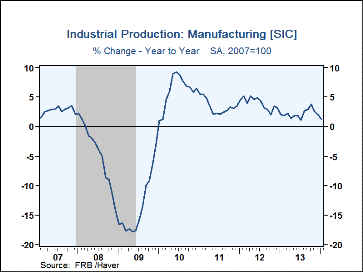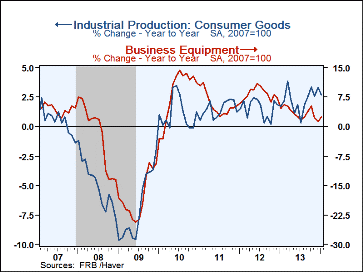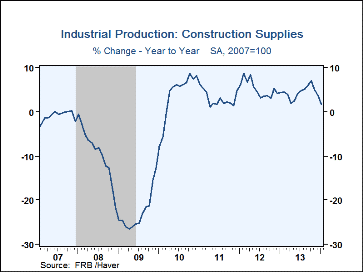 Global| Feb 14 2014
Global| Feb 14 2014U.S. Factory Output Declines Sharply
by:Tom Moeller
|in:Economy in Brief
Summary
The output of U.S. factories fell 0.8% (+1.3% y/y) during January following 0.3% gains during the prior two months, both revised down from 0.5%. The latest decline was the largest since May 2009. Overall industrial production fell a [...]
The output of U.S. factories fell 0.8% (+1.3% y/y) during January following 0.3% gains during the prior two months, both revised down from 0.5%. The latest decline was the largest since May 2009. Overall industrial production fell a lesser 0.3% (+2.9%y/y) as utility output ramped up 4.1% (9.4% y/y) with colder temperatures. A 0.3% increase in total production was expected in the Action Economics forecast survey.
The largest sector shortfall in January was in construction supplies where production declined 1.0% (+1.7% y/y). In addition, a 0.5% drop (+2.7% y/y) in consumer goods output was led by a 5.0% drop (+2.8% y/y) in motor vehicle & parts output. Electrical equipment production fell 1.9% (+1.2% y/y) while furniture output was off 1.2% (+5.0% y/y). Working the other way, computer & electronic components production improved 0.9% (4.2% y/y) and machinery output gained 0.6% (3.3% y/y). Amongst nondurable goods industries, textile production fell 1.7% (-3.2% y/y) and chemical production was off 0.7% (+0.3% y/y).
In the capital goods sector, output slipped 0.1% (+2.4% y/y). Output of transit equipment fell 1.3% (+2.8% y/y) but production of information & processing equipment gained 1.3% (1.9% y/y). Factory sector activity excluding the high tech & auto industries declined 0.5% (+1.0% y/y) last month. The y/y gain slowed, however, from its October peak of 3.2%.
The capacity utilization rate edged down to 78.5% last month from a downwardly revised 78.9%. That remained below the 80.5% high averaged in 2007. In the factory sector, the capacity utilization rate fell to 76.0% and remained below 78.6% before the recession. Growth in total industry capacity was 1.8% y/y versus a 2.2% rise in 2012.
Industrial production and capacity data are included in Haver's USECON database, with additional detail in the IP database. The expectations figure is in the AS1REPNA database.
| Industrial Production (SA, % Change) | Jan | Dec | Nov | Jan Y/Y | 2013 | 2012 | 2011 |
|---|---|---|---|---|---|---|---|
| Total Output | -0.3 | 0.3 | 0.7 | 2.9 | 2.6 | 3.6 | 3.3 |
| Manufacturing | -0.8 | 0.3 | 0.3 | 1.3 | 2.2 | 3.9 | 3.4 |
| Consumer Goods | -0.5 | 0.6 | 0.7 | 2.7 | 2.2 | 1.6 | 1.5 |
| Business Equipment | -0.1 | -0.7 | -0.4 | 2.4 | 3.5 | 8.3 | 5.6 |
| Construction Supplies | -1.0 | -0.6 | 0.4 | 1.7 | 4.4 | 5.2 | 3.0 |
| Materials | -0.3 | 0.5 | 1.0 | 3.4 | 2.8 | 4.1 | 4.7 |
| Utilities | 4.1 | -1.4 | 2.9 | 9.4 | 1.8 | -2.1 | -0.2 |
| Capacity Utilization (%) | 78.5 | 78.9 | 78.8 | 77.7 | 78.2 | 77.6 | 76.5 |
| Manufacturing | 76.0 | 76.7 | 76.6 | 76.2 | 76.3 | 75.8 | 74.0 |
Tom Moeller
AuthorMore in Author Profile »Prior to joining Haver Analytics in 2000, Mr. Moeller worked as the Economist at Chancellor Capital Management from 1985 to 1999. There, he developed comprehensive economic forecasts and interpreted economic data for equity and fixed income portfolio managers. Also at Chancellor, Mr. Moeller worked as an equity analyst and was responsible for researching and rating companies in the economically sensitive automobile and housing industries for investment in Chancellor’s equity portfolio. Prior to joining Chancellor, Mr. Moeller was an Economist at Citibank from 1979 to 1984. He also analyzed pricing behavior in the metals industry for the Council on Wage and Price Stability in Washington, D.C. In 1999, Mr. Moeller received the award for most accurate forecast from the Forecasters' Club of New York. From 1990 to 1992 he was President of the New York Association for Business Economists. Mr. Moeller earned an M.B.A. in Finance from Fordham University, where he graduated in 1987. He holds a Bachelor of Arts in Economics from George Washington University.










